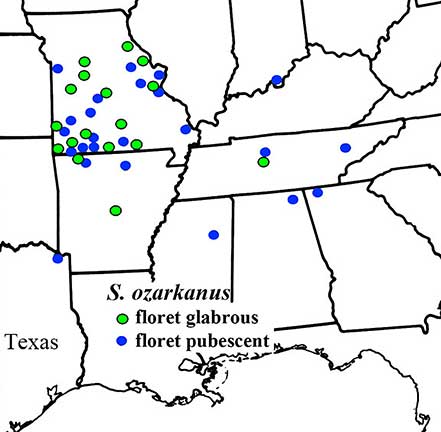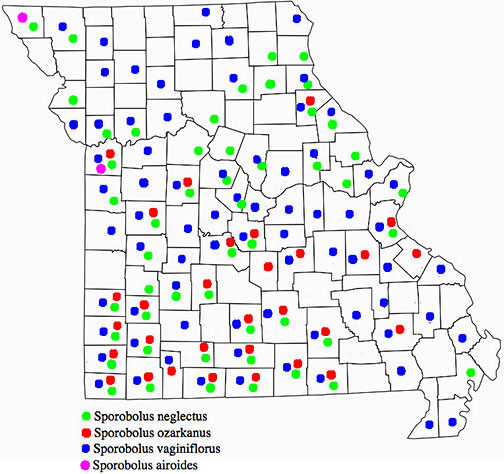


This map is a detail adapted from Riggins 1969, p 66.
Riggins, pp. 64 & 67 gives the following details:
Distribution and Ecology
My collections and other herbarium specimens show that the distribution of S. ozarkanus covers a greater geographical area than Steyermark (1961) indicated. The species is most abundant in the Ozark region of Missouri and Arkansas. The Ozark region of Missouri is characterized by limestone, chert, sandstone and granitic rocks. Outcrops and surface-exposed rooks form open glades with shallow soil and little tree and shrub vegetation. Juniperus virginiana L. is a frequent inhabitant of limestone glades (Steyermark 1961) . Similar glade areas with abundant Juniperus are found in northern Alabama and the Nashville Basin of Tennessee (Harper, 1926). Habitat data from Duncan 1322, collected in Catoosa County, Georgia, affirm that cedar glades also occur in that area.
Location and habitat data indicate that S. ozarkanus is particularly associated with limestone. The specific habitats given include limestone barrens, slopes, glades and ledges. The habitats are similar throughout the geographical range shown in the above map.
Within the Ozark region the distribution of specimens with glabrous or pubescent lemmas is practically the same. Specimens with glabrous lemmas are essentially confined to this area. The one exception occurs in Williamson County, Tennessee, an area within the Nashville Basin. Other specimens of S. ozarkanus occurring outside the previously reported range of Missouri and Arkansas have pubescent lemmas.

The online Atlas of Missouri Vascular Plants at Missouri State University shows that this group is well represented over the entire state, but especially the more locally restricted S. ozarkanus. The map below is a colorized combination of four maps (the S. vaginiflorus complex plus S. airoides). S. airoides was added in view of a 2014 molecular study by P.M. Peterson et al. suggesting a hybrid origin for S. ozarkanus (Sporobolus: phylogeny and classification, Taxon 64, p. 1229):
… in the combined plastid tree S. vaginiflorus var. ozarkanus falls within the S. airoides clade … Acquisition of the S. airoides plastid haplotype is probably the result of an ancient hybridization event.
Note that S. airoides occurs in two counties on the W edge of the state and is sympatric with both S. vaginiflorus and S. ozarkanus in one county.
In most Missouri counties where S. ozarkanus occurs it is sympatric with both S. vaginiflorus & S. neglectus. This distribution would seem to support the view that S. ozarkanus is a distinct species. Since these taxa are all highly cleistogamous, Riggins’ breeding data support limited outcrossing (pp. 26-28):The presence of the longer anthers with many pollen grains indicates that there is a possibility of chasmogamy for each species. It is not known whether chasmogamy occurs regularly and frequently in wild populations. The percentage of outcrossing would undoubtedly be low since only a few spikelets per plant have the potential for outcrosssing. … Although it is probable that limited outcrossing occurs in natural populations, the variation patterns of greenhouse-grown progeny do not reflect any gene flow between the various phenotypes grown in close proximity.